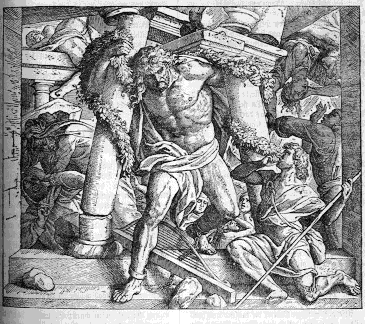Samson Agonistes
|
|
Samson Agonistes (Greek: "Samson the agonist") is a work of blank verse tragedy by John Milton. It first appeared in 1671 when printed into a single volume with Milton's Paradise Regain'd. Scholastic arguments for the date of authorship are similar to those of Paradise Regained, but it is generally agreed that it was begun around the same time and completed after the larger work, possibly very close to the date of publishing.
A retelling of the story of Samson in Judges 13-16, it bears many similarities to Milton's other works, especially Paradise Lost and Paradise Regained. Like these works, Samson Agonistes follows many conventions of the Greek Classics, specifically attention to verisimilitude, a chorus, a sympathetic hero, and a small cast of players. It also bears many correlations to Milton's life and gives the modern scholar insight into Milton's attitudes about his own life and religion.
Samson Agonistes is the conversation of a man forced to labor in pain while in captivity as the result of his own foolishness. The heavy labor and embarrassment of pushing a grain mill, a task often given to oxen or donkeys, add to the pain of the scars of savage beatings and blindness after the Philistines gouged out his eyes. "Blind among enemies, O worse then chains. (66)"
This physical pain is coupled with the mental anguish (that is the Greek definition of agony) brought on by knowledge that his current low estate is a direct result of a broken vow to God (his secret revelation of the source of his God-given strength) and subsequent betrayal by Delilah, the woman he loved.
Milton even dramatizes a conversation between Delilah and Samson. In this passage, Milton tries to paint Delilah as a more innocent person, a woman who foolishly betrayed a man and then regrets it. This foolishness is attributed to her inability to overcome emotion as a result of her belonging to the weaker sex, a theme mirrored in a discussion of Eve in Paradise Lost.
As blindness overtook Milton, it becomes a major thematic point in Samson Agonistes, and is seen also in Paradise Lost (3.22-55) and his 16th Sonnet. Many scholars have written about the impact of Milton's increasing blindness on his works. This recurrence of blindness came after Milton temporarily gave up his poetry to work for Oliver Cromwell and the Commonwealth government. He continued this service even though his eyesight was failing and he knew that he was hastening his own blindness. The correlation is significant to the Agonistes plot: Milton describes Samson as being "Eyeless in Gaza", a phrase that has become the most quoted line of Agonistes. Novelist Aldous Huxley used it as the title for his 1936 novel Eyeless in Gaza.
The inevitability of circumstance, or rather, the sympathy through perceived innocence of the protagonist and those around him, is characteristic of Milton in all of his Biblically based works, and, subsequently, very characteristic of Milton's persona as the modern scholastic understands him.
The Persons (Cast)
- Samson
- Manoa the Father of Samson
- Dalila his Wife (It should be noted that she is never noted as his wife in any Biblical text.)
- Harapha of Gath
- Publick Officer
- Messenger
- Chorus of Danites
External links
- The complete text of Samson Agonistes (http://www.dartmouth.edu/~milton/reading_room/samson/drama/index.shtml) with study aides, presented by Dartmouth College.
- The text of Judges 13-16 (http://www.biblegateway.com/cgi-bin/bible?language=english&passage=Judges+13-16&version=KJV) (King James Version) at biblegateway.com (http://www.biblegateway.com).

